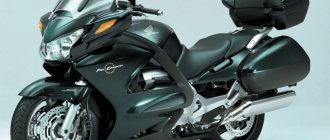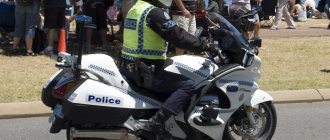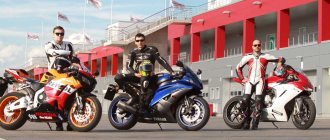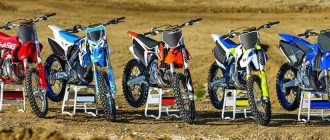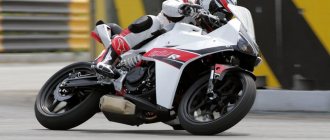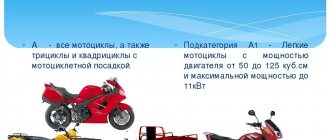- motorcycle model, Yamaha brand,
The Yamaha FJR 1300 sports tourer model was first introduced in 2001 as a successor to the obsolete version of the Yamaha FJ 1200. Despite the stated continuity, the FJR 1300 model has become a completely independent development and has nothing in common with the previous FJ1100/FJ1200 models. From the very beginning, the motorcycle positions itself as the flagship sport-tourer in the Yamaha line of models, intended for sales in foreign markets - in particular, Europe and North America. In addition, the Yamaha FJR 1300 was officially available in a number of other countries - for example, in Oceania and South Africa.
The Yamaha FJR1300 was based on an in-line 4-cylinder liquid-cooled injection engine with a capacity of 1298 cc. see, producing 143 hp. power and 134 Nm of torque. In 2013, the catalysts were optimized and maximum power increased to 146 hp and torque to 138 Nm. Maximum engine performance is achieved at 7000-8000 rpm. Despite the outstanding technical characteristics, the official fuel consumption is stated at 6.2 l / 100 km.
Other features of the Yamaha FJR1300 include an aluminum frame, the ability to electronically adjust the suspension (AE version since 2013), cruise control, an electrically adjustable windshield, seat height adjustment, a combined braking system with ABS, and the availability of versions with a semi-automatic transmission (electronic clutch on AS/AE versions), traction control system, 6-speed gearbox (since 2016), 25 liter fuel tank, cardan drive and 275 kg curb weight.
Bike features
Here are the main features of this model, bright in every sense:
- massive dimensions even for a sports touring motorcycle;
- good brakes, which, however, will not save a beginner from a sudden start;
- Possibility of both sports and classic landings.
The motorcycle can be hung with panniers, which are made at a high level. However, not every person, even if he is a three-time traveler, will be satisfied with the width of the bike along with such a body kit of 1250 mm. If the need arises to take a bunch of things with them, many will prefer the usual tourist classics.
Flaws
For the explosive temper and powerful muscles of the bike you have to pay with a ravenous appetite. With active driving, it can swallow about 10 liters per hundred, and even at a measured pace, it is unlikely to use up less than seven liters of 92. Although, to be fair, let’s say that models produced after 2015 slightly curbed their appetites due to being equipped with an injector.
Despite its good balance and handling, this mustang will be a challenge for a beginner to rein in. Still, more than 2 quintals and over 100 horses require certain driving experience and physical dexterity.
But experienced speed fans are crazy about this motorcycle, and despite the fact that the model was released in the last century, it can often be found on the roads of different countries.
Engine
Torque of 136 Nm and power of 140 hp. – very decent maximum characteristics for such a machine. In-line, the engine is a liquid-cooled four. The top speed here is 260 km/h, which is very good for a motorcycle that began its journey back in the early 2000s. The bike won't even need 3 seconds to reach a speed of 100 km/h.
Yamaha FJR1300: electronic options
ABS
YCC-T - Yamaha Chip Control Throttle (electronic throttle) - since 2013
YCC-S - Clutchless Shift System - FJR1300AE/AS/ES
TCS (Traction Control System) (traction control system) - since 2013
Cruise control (electronic cruise control system) - since 2013
Yamaha D-Mode-System - since 2013
Electronic adjustment suspension (electronic suspension) - AS/AE/ES from 2013
Dimensions and weight
The dry weight here is 250 kg, but taking into account the 25 liter tank it increases to approximately 290 kg. No, the bike feels light on country roads and handles great. However, riding the FJR 1300 in the city is a completely different story. The saddle height of 850 mm makes the model clearly unsuitable for people of short and even average height.
Yamaha FJR1300A. The Motherland is calling
From its very appearance, the motorcycle aroused in people the desire to go on a long journey. Among the variety of modern bikes, there are also touring models specially designed for travel. The sports touring Yamaha FJR1300A is a prominent representative of this type
Natalia Umnova
Yamaha FJR1300A. Price: from 812,000 rub. On sale: since 2013. From its very appearance, the motorcycle aroused in a person the desire to go on a long journey. Among the variety of modern bikes, there are also touring models specially designed for travel. The sports touring Yamaha FJR1300A is a prominent representative of this type.
Yamaha FJR1300A. Photo: Alexey Voznyuk
The Yamaha FJR1300A is a sport-touring motorcycle designed to cover long distances quickly (this is the key!). This device loves endless smooth straight lines, on which it can accelerate to 250 km/h, or no less smooth curves - European coasts and serpentines, where it takes turns with pleasure... That is why I decided to test the FJR1300A in “non-target” conditions - on the roads of central Russia and the Volga region, although quite straight, but clogged with trucks and not always smooth.
Heated grips are standard, and saddlebags are an option. It’s strange, but perhaps the package will be changed. Photo: Alexey Voznyuk
One of the sections of the route made FJR and I nervous: the seemingly smooth surface actually had ripples, on which the motorcycle jumped and twitched slightly. Here the telescopic fork and the driver had a hard time: a simple “telescope” handles bumps worse than an inverted one, all the cracks and bumps fall into the hands, which bear the entire weight of the driver during a sports-tourist landing. But despite this, we overcame the unpleasant section without losses, only reducing the speed to 80 km/h.
Yamaha FJR1300A. Photo: Alexey Voznyuk
The rest of the route, when there was no heavy traffic, went faster, although there were no empty straight lines to accelerate much - you just unscrew the handle and a truck loomed ahead or the smooth road ended. And the motorcycle clearly wanted to be annealed! In-line “four” with a volume of 1298 cm3 and a power of 146 hp. With. with a torque of 138 Nm in “touring” mode, it operates smoothly at 3–4 thousand rpm, powerfully and smoothly accelerating the motorcycle from any speed. But as soon as you pick up speed or switch to “sport” mode, the device transforms (it’s not for nothing that it’s a sports tourer, that is, 2 in 1), a trembling runs through the body, and it leaps forward - just hold on!
The only drawback of the motorcycle is the rear view mirrors attached to the fairing: they get in the way in traffic jams. Photo: Alexey Voznyuk
The reserve of dynamics in any mode of engine operation is enough for quick, safe overtaking at any speed, however, excellent aerodynamics and a button-adjustable windshield do not allow you to fully experience this speed - you cannot catch the wind in your face and chest. But you don’t have to strain yourself, clinging to the motorcycle so as not to blow away. Plus, on the FJR you can easily raise the saddle a couple of centimeters and adjust the position of the handlebars.
Comfort is also added by the air flow distribution system, which directs heat from the engine to the driver’s feet - a great thing in cool and wet weather. But in the heat and in a traffic jam, when additional air cooling does not work, it greatly interferes: you don’t know where to put your feet from the blazing engine.
Yamaha FJR1300A. Photo: Alexey Voznyuk
Like a self-respecting modern motorcycle, the Yamaha FJR1300A is equipped with ABS, while the brakes themselves work perfectly, adequately and predictably slowing down the device from any speed. In addition, there is a switchable traction control system (TCS), which prevents stalling and slipping of the rear wheel, which is valuable when driving in the rain and when cornering, which the FJR handles perfectly - it’s not for nothing that it has a sports aluminum frame. But even though there are seven bends per mile on Russian roads, sharp turns where you can go all the way to the running boards are rare.
Cruise control works at 50–180 km/h, giving rest to the right hand. Photo: Alexey Voznyuk
The motorcycle provided a pleasant feeling even in not the most pleasant conditions. With the Yamaha FJR1300A you can be sure: when you are fed up with smooth Europe, and the Motherland calls you to taste its immense distances, it will not shy away from this challenge.
Yamaha FJR1300A. Photo: Alexey Voznyuk
Yamaha FJR1300A
| Dimensions (length x width x height x seat height) | 2230x750x1325x805 (825) |
| Base | 1545 mm |
| Ground clearance, mm | 130 |
| Fuel tank capacity l | 25 |
| Engine | 1298 cm3, 4-cylinder, in-line, 4-stroke, liquid-cooled, injector, 146/8000 l. s./min-1, 138/7000 Nm/min-1 |
| Transmission | 5-speed manual gearbox, multi-plate clutch, oil bath, drive - cardan shaft |
| Frame | aluminum, diagonal |
| Front suspension | telescopic fork, ∅ 48 mm, stroke 135 mm |
| Rear suspension | adjustable monoshock, 125 mm travel |
| Front brakes | 2 discs ∅ 320 mm |
| Rear brakes | hydraulic 1 disc ∅ 282 mm |
| Dry weight | 259 kg |
| Technologies | ABS, traction control, cruise control |
The editors recommend:
KAMA PRO - extended-life tires
The Russian car market has collapsed by 20%
Service station workers face prison for driving a client's car
Russian car dealers have surpassed Italian ones
News Media2
Discussion Cancel
I want to receive the most interesting articles
Chassis and brakes
The model's suspension is well made. If at the rear there is a typical reliable solution in the form of a pendulum version with a shock absorber, then at the front there is a large telescopic fork, the travel of which is quite free and amounts to 135 mm.
The rear brake is a disc with a two-piston caliper, while the front is a pair of discs with four-piston calipers. The diamond-shaped frame is made of aluminum; apparently, the designers were well aware that the FJR 1300 was already very heavy for its class.
Landing a motorcycle
The motorcycle seat is comfortable, the body sits straight, the limbs are relaxed. If desired, for example, when driving for many thousands, you can easily change your position: sit in the passenger seat or move your feet to the rear footrests, allowing your stiff muscles to come to their senses. Also on the Yamaha FJR 1300 you can adjust the position of the steering wheel, seat and windshield. So the driver can adjust his seat to suit himself, regardless of height.
Somewhat unusual hips. The tank of the FJR 1300 is large enough that when you wrap your legs around it, you feel like Baron Munchausen riding on the core. However, you quickly get used to it, and then you begin to appreciate it. Not because you feel special in this position, but because of the volume of the tank. 25 liters is a good figure for such a motorcycle, especially considering the moderate appetite.
History of changes
During its career, the FJR 1300 has already come a long way:
- 2001 – start of production;
- 2003 – ABS appears;
- 2006 – significant restyling;
- 2008 – improvement of ABS;
- 2013 – large-scale technical changes;
- 2016 – slipper clutch appears.
It’s difficult to say how big the future is for this motorcycle, but even if it suddenly stops being produced, it will not lose its popularity for a long time.
Main generations of Yamaha FJR 1300:
2001-2002 - first generation. Models of these years do not have ABS, are equipped with 298 mm brake discs (from YZF-R1) and do not have an immobilizer.
2003-2005 - second generation. The motorcycle receives new 320 mm front brake discs, an ABS system (standard in the European market) and an immobilizer.
2006-2012 - third generation. In addition to visual changes, the model receives ABS as standard equipment in the markets of all countries, modifications AE (North America) and AS (Europe) with a semi-automatic transmission appear, the gearbox ratio changes slightly, and a new generator with 590 watts (instead of 490) is installed.
2013-2015 - fourth generation. The model receives visual changes and a variety of electronic systems: electronic throttle, cruise control, traction control, Yamaha D-Mode-System, electronic suspension adjustment and inverted forks (on the AS/AE version - with a semi-automatic transmission).
2016+ - fifth generation. The main differences are the 6-speed gearbox, slipper clutch and LED optics. More expensive versions of AE/AS/ES get adaptive headlights.
